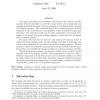Free Online Productivity Tools
i2Speak
i2Symbol
i2OCR
iTex2Img
iWeb2Print
iWeb2Shot
i2Type
iPdf2Split
iPdf2Merge
i2Bopomofo
i2Arabic
i2Style
i2Image
i2PDF
iLatex2Rtf
Sci2ools
SIAMAM
2008
2008
Transport-Based Imaging in Random Media
This paper generalizes well-established derivations of the radiative transfer equation from first principles to model the energy density of time-dependent and monochromatic high frequency waves propagating in a random medium composed of localized scatterers. The correlation length of the random scatterers is small compared to the overall distance of propagation so that ensemble averaging may take place. The correlation length may be either comparable to the typical wavelength in the system (the weak-coupling regime) or larger than the wavelength (the low-density regime). The paper also considers the detection and imaging of inclusions buried in highly scattering random media. In such multiple scattering environments, the coherent wave fields may be too weak to be used for imaging purposes. We thus propose to model the inclusions as parameters in the macroscopic radiative transfer equations and consider the imaging problem as an inverse transport problem. Numerical simulations address ...
| Added | 14 Dec 2010 |
| Updated | 14 Dec 2010 |
| Type | Journal |
| Year | 2008 |
| Where | SIAMAM |
| Authors | Guillaume Bal, Kui Ren |
Comments (0)

